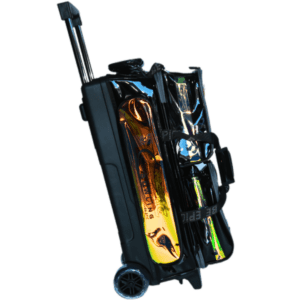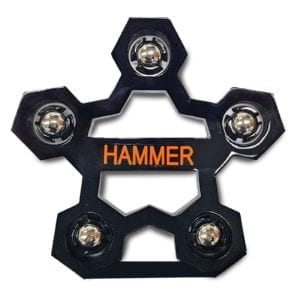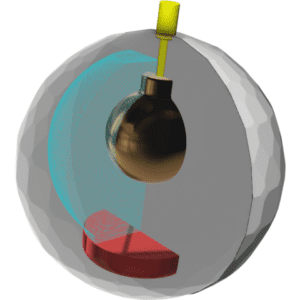Bowling Ball Videos, Bowling Tips & Coaching Articles, Storm Bowling Ball Videos
Storm Parallax Bowling Ball Drilling & Layout Comparison – PSA to PAP


For this article, the second in a three part series, we are going to continue our deep dive into understanding the effect of different layouts with the Parallax™ and its new Aeroflo™ Core.
As we learned in our first article featuring Chad McLean and his demonstration of different Pin to PAP distances, adjusting the distance of the pin from your positive axis point creates a much different ball motion, especially for those with higher rev rates because they have the greater hook potential. One with a very low rev rate and low axis rotation would surely not see as much of a difference between layouts. My bowler stats wouldn’t quite put me in the very low rev rate category, but as we dive into the results, know that, if your rev rate is faster than mine, you may see an even bigger difference in ball motion by adjusting the PSA.
For this article and video, we locked in two of the three measurements of the layout, the Pin to PAP and the Pin buffer distance. As you can see in the image here, doing so positioned the pin just above and outside of the ring finger. If we were to keep with the standards of the warranty requirements, we would have shortened the pin buffer to create more space between the edges of the pin and the ring finger, so please keep that into consideration as you or your pro shop operator select layouts for you.

Before hitting the lanes, we wanted to share the following information which many consider to be highly technical. So, if that’s not you, feel free to jump ahead to get right into the effects the layout adjustments had on ball motion! Many are familiar with the RGs (radius of gyration) and differentials as they are located on nearly every crazy 8 displayed in all pro shops as well as every ball page on every manufacturers website. But what you won’t always hear come up is that these RG values, and thus differentials, change once holes are drilled in the ball. There is no escaping or changing that…it happens whether you like it or not.
In this image you will see that the RG values remained quite constant among the three different drilled balls, with one exception. Can you spot it? 
It’s the third number in the 5 x 2 x 2… the intermediate mass bias of 0.021. While that ball remained the closest to the un-drilled ball, you can see in looking at all three drilled balls that the other two balls, the 5 x 4 x 2 and 5 x 6 x 2, were the most similar to each other dynamically speaking.
Stepping up on the lanes, we started with the 5 x 2 x 2 to see what type of motion we would get with it and to use that as the baseline for this test.

We selected Kegel’s 39 foot Middle Road pattern which would typically entice you to position your breakpoint near the 8 board when using Kegel’s “Rule of 31” which says that if you take the length of the oil pattern and subtract 31 that you will get the point at which your ball should leave the oil to have the best angle to towards the pocket.
Sliding 22 and keeping our target at the 12 board gave us a great look to the pocket. This type of layout, with the PSA near the VAL (vertical axis line), is most often preferred by players at the highest level looking to gain a reasonable amount of control on the backend. And if you look at the numbers below, specifically the position at the head pin and the entry angle, you will see that this one, the 5 x 2 x 2, ended up the most light in the pocket and produced the least amount of entry angle.

Moving on to the second Parallax, the 5 x 4 x 2 layout, we immediately notice the ball finishing much deeper in the pocket, almost a board and a half!

That may not sound like much, but rest assured that it was eye opening since we used Specto to confirm that nothing had changed with respect to our speed and laydown or launch angle. We were strictly seeing the effects of moving the PSA 2 inches farther away from the PAP than in the first test. We also saw our entry angle go up from 3.59 degrees to 4.16, an increase of more than 15%. These are some big numbers where looking at what some view as slight tweaks to the layout.
And finally, we rolled the third Parallax, the 5 x 6 x 2, which positioned the PSA just to the left side of the thumb hole.

A layout not typically used or as popular for those looking for a big change of direction, the 5 x 6 x 2 created the latest break point distance of the three. And with respect to the total ball motion, which references the position of the ball at the head pin, and to entry angle, we saw this third Parallax fall right in-between the first two on both accords. It was a fine balance of an aggressive skid-flip motion with ample control. We could see this one working on a wide variety of conditions and surfaces, especially if you’re like me with respect to a lower rev rate and a preference to play the lanes with a more direct line to the pocket.
In summary, thanks for your interest in learning some of the finer details with respect to layouts. For more detailed information and understanding, be sure to visit Storm’s YouTube channel and search for the Pin Buffer Layout System. You’ll find three very detailed videos that are sure to help you dial in your arsenal of equipment with ball choices and layouts in no time. To see the video specific to PSA location, watch the video below:

















































































